Coffee & The Great Commission
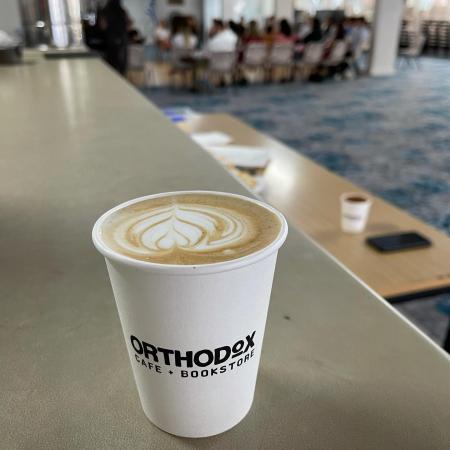
The Story of Sydney’s Orthodox Café + Bookstore
An Interview with Kimon Giannopoulos and John Varipatis
By Virginia Nieuwsma
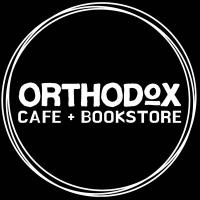
In February of 2020, before the world knew that the COVID-19 tsunami was just around the corner, two members of the St. Stylianos parish in Sydney, Australia (Greek Orthodox Archdiocese of Australia) met at a coffee house with Fr. Chad Hatfield. Father Chad was on a tour of the “land down under” teaching, speaking, and strengthening the Seminary’s relationships there. At the coffee house, the two men began discussing with Fr. Chad their plans to start the Orthodox Café + Bookstore. As students of St. Andrew’s Greek Orthodox Theological College, they had been inspired by Fr. Chad’s class on missiology, which they undertook not long before at St. Cyril’s Coptic Orthodox Theological Seminary. The two wanted to get his perspective on their ideas. Ten months later, even with the challenges of 2020, Kimon Giannopoulos and John Varipatis managed to get their venture off the ground despite their family commitments and busy professional careers. In a Zoom interview, they told us how—and what’s ahead.

John Varipatis, Katie Giannopoulos, Eva Giannopoulos, Dean Giannopoulos, Kimon Giannopoulos, and Vasilia Varipatis
Tell us about the Orthodox Café—its origins and its unique ministry.
Kimon
The Café is basically a great excuse for fellowship; Fr. Chad would attest to this, that one of the ministry challenges our clergy and clergy-to-be are facing is, how do you get young adults in the secular world to understand Orthodox spirituality and what it has to offer? Even the most embedded people like John, the son of a priest, tend to lose touch with the Church when they are in their late teens and twenties.
We’ve reviewed the census data, and since 1970 there has been a 30 percent drop in Christianity in Australia, with the biggest drop occurring in the 18–35-year-old age range. We’re losing people in this period of their lives; instead, they are going after yoga, Buddhism, self-reflection, “mindfulness training,” or other spiritual paths that might mimic some aspects of our Faith but aren’t the real answer. We’ve been missing the opportunity to bring Orthodoxy into the world. We realized that unless we began to get out there and talk about the reduction of young adults in the Church, we would lose this generation. And we didn’t want to use the word “fellowship,” which to us meant, “a group of people you have to hang out with.” What was needed was an outreach post, a gathering place, a comfortable community.
So, one day after class with Fr. Chad in February, we approached him and our first question was, “Do you drink coffee?” “Absolutely!” he said, so off we went down the street to the local coffee shop, where we told him over our chosen drinks, “Fr. Chad, we’ve got this idea. See how quickly you wanted to go for a walk and talk about theology over coffee?” We told him we felt there was an opportunity here, because the first thing you do in Australia when you want to catch up on a personal issue or meet with friends is you ask, “Are you free to grab a coffee?” We told him we wanted to create a community that was broad enough to be pan-Orthodox, because even though we are Greek Orthodox, our vision was to have any type of Orthodox Christian as well as inquirers join us.
We obtained our local bishop’s blessing, His Grace Bishop Emilianos of Meloa, and our priest’s support to use our large parish hall as our Orthodox Café space. People donated a refurbished coffee machine and about 10,000 coffee cups with our Café brand printed on them, so we managed to kick off the venture pretty much for free. At some point we began to sell our coffee beans and put together a supply chain where we can sell them at a competitive price in Australia. A lot of people ask, “Can we buy your beans?” without realizing that they are participating in an Orthodox mission outreach.
Of course, we started all this up around the time COVID arrived! John and I decided to embark on this mission plan because we felt that we weren’t busy enough [laughter]. We didn’t sleep in the best of times, and then when we began this ministry our wives were asking, “Are you sure you’ve got time for this additional work?” and we said, “Oh, we’ll fit it in, we don’t need sleep!”
John
One of the most amazing things we saw was that people in Orthodox communities want to help the Church. We just went to our parish priest with this idea and we didn’t have anything other than a nice church hall. I was bringing my old coffee machine from home when we first started the Café. Parishioners were more than happy to give to this, recognizing that there was a gap here in the Church that we haven’t been addressing, and that there is this young adult population that we’re just starting to capture now with the Café. We’ve been able to generate revenue by selling our coffee beans and selling books, so we’re making enough to stand on our own two feet.
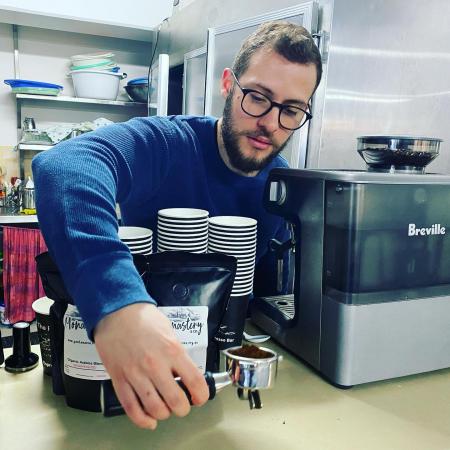
Coffee is merely an excuse to get people to come together. The crux of the Café is the book side of things, the conversation side of things, with discussion where we can all learn about each other and discuss our spiritual questions; then we can help each other through the books and open discussion. It’s very humanizing and provides us a way to invite young adults into the Church. Our archbishop in Australia, His Eminence Archbishop Makarios, has said that “I have a dream for this Church, that the people who are outside, to be inside and that the people who are inside to open their hearts to those outside,” and this resonates strongly with us and is one of our goals for the Café.
How did St Vladimir’s enter into this picture?
Kimon
Back in June of 2019 I flew to New York for a meeting with investors for my work. Along with the sub-dean, Dr. Philip Kariatlis, from our Seminary, St Andrew’s Theological College, I was able to take the train from Grand Central up to the Crestwood station and visit the campus. I was just amazed at the atmosphere at St. Vladimir’s. I thought, “If this isn’t heaven on earth, I don’t know what is!” While we were touring the chapel, Fr. Chad stepped out of the side of the iconostasis and warmly welcomed us, even though he was preparing for the service to start. Then we were able to worship in Three Hierarchs Chapel, experiencing the beautiful liturgy in four-part harmony—it was amazing.
Father Chad also took us around for a tour of the whole campus; library, gym, bookshop, seminary housing. I felt such a connection with St. Vladimir’s even with the thousands of kilometers of sea we have between us.
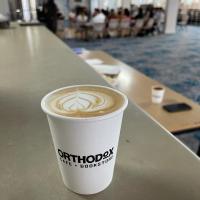
At some point Fr. Chad mentioned that he was coming to Australia in February and doing a missiology class. I said, “Missiology? What’s that?” and he said, “That thing that Christ said—the Great Commission!” On the train back to Grand Central after our visit I said to Philip, “This is how I can add value to the Church, through mission work! With my experience in the corporate world, there has got to be a way for me to apply my skills to help bring people closer to Christ.” And that was the germ for the Café idea, which then came into sharper focus in Fr. Chad’s missiology class the following February.
Fast forward to our after-class coffee with Fr. Chad. He told John and I, “The key challenge you guys will have to face in doing this is that you will be taking a risk.” This was really the message of his entire course: mission requires people to take risks for Christ and His Church. We have found this to be true: John and I have been taking lots of risk since that coffee with Fr. Chad but his course helped us prepare for that.
How did the Press become a part of your mission plan?
Kimon
John and I were influenced by a quote we read, that books have become marginalized and treated as something we only put on our shelves. We decided that we wanted to see books opened and discussed, and in so doing, we would be able to explore the message of the gospel through the eyes of different authors. Of course, the preeminent books are the four Gospels but then our Orthodox fathers, mothers, and saints have so much to teach us. When we drew people to the Café we knew we needed to have solid content and writing that would hold their attention.
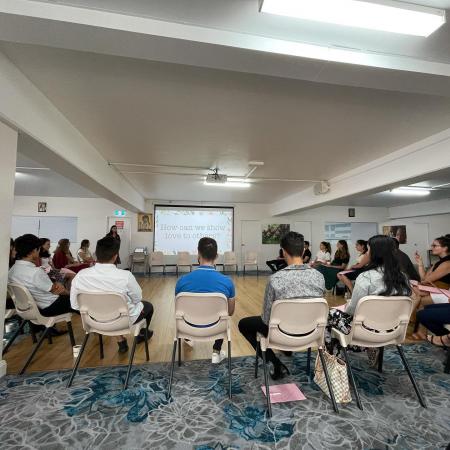
Thanks to the team at SVS Press, we are going to receive a whole “small bookstore” that we can make available through the Café to kick off our store. We get weekly texts from members of the Café asking, “Can you get me this book?” “I’m interested in the spiritual life; can you point me in the right direction?” We show videos too; instead of reading the book first and then watching a video, this generation tends to want to see the video first and then buy the book! We keep our agenda fresh with books, videos, activities, and speakers; right now, we’re writing Christmas cards for the elderly. We’ve also sponsored an Orthodox film festival, Byzanfest, and played many of these Orthodox films at the Café during November. But our end goal is always to bring these young adults into the experience of the Divine Liturgy; that’s success for us.
John
At the beginning, we started with what we had, with the books that were at our disposal and the location we had at our disposal. We were blown away by how many young adults joined the conversation and by the depth of the conversations we were having. Not everyone bought a book on the first day of the Café, but as people started returning, they told us what they were interested in, and we were able to recommend books and explain how those titles could be relevant to them and help answer their questions. Everything came to fruition with our willingness to start using the small infrastructure at our disposal.
Where do you hope to go from here?
John
We are talking to other parishes and looking to open another Café that’s centrally located in the heart of Sydney. We’re also looking at a possibility to bring a Café to the other side of Australia in Perth, so we’re in conversation with a parish priest there. We hope to share our ideas and our template for this start up to let as many people use it as possible. A bookstore/coffee shop is a place where conversions happen and where people can learn about the Faith. Why limit it just to the southern part of Sydney? Franchise, that’s the goal. We’ll be competing with Starbucks! Anyway, everyone in America says that Australian coffee is so good!
Kimon
We want to get other parishes on board and take the complexity out of setup: books, coffee beans, logistics. The thing they need to do is follow the model and methodology.
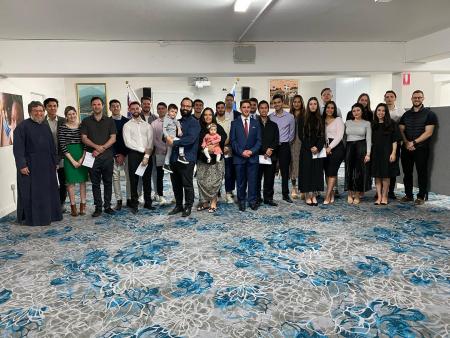
Something we learned early on is that missions need the blessing of the bishop. When you take these risks, you have to do them with your parish priest’s and bishop’s blessings. We also got great support from our archbishop—in fact, the meeting started with, “Do you guys want an espresso?” He was so loving and heartfelt in his empathy for the young adult community. He even shared his dream that we would have a central café right in the Archdiocese headquarters overlooking the beautiful Prince Alfred Park in Sydney. We also have the idea of partnering with aged care facilities, joint ventures so to speak, to connect the elderly with the youth.
Our brains never stop thinking about ideas!
Is Fr. Chad still involved with this effort?
John
Throughout the project, we have been talking with Fr. Chad quite frequently. He has pointed us in the right direction and linked us with the right people. At some point in our regular meetings with him he introduced us to Sarah Werner at SVS Press, and she has given us a great rate for our books and been very helpful.
Kimon
Without having had the connection with Fr. Chad, taking his course, having that experience for two weeks with him (the mission plan we wrote was actually an assignment for his class!), having his help to strategize, then making the connections with other people like Sarah Werner through him—I’m certain that without St. Vladimir’s Seminary and Fr. Chad, this would not have happened, it’s as simple as that.
Interested in learning more?
Contact Kimon and John at info@orthodoxcafe.com
LINKS
https://www.facebook.com/orthodoxcafe.com.au/
https://www.instagram.com/orthodoxcafe/?hl=en
https://twitter.com/CafeOrthodox
https://www.saintstylianos.org.au/
https://www.sagotc.edu.au/news/orthodox-cafe
View YouTube Videos of Orthodox Café Talks:
https://www.youtube.com/channel/UCef541cUf9UXkW09F1kkVKw
Read about Fr. Chad’s February 2020 Australia trip:
https://www.svots.edu/headlines/seminary-president-strengthens-ties-australia
John Varipatis has been married for two years to Vasilia; they both have called Sydney, Australia home for their entire lives. John's parents, Fr. Constantine and Presvytera Eleni, have three children; John and his twin brother George have an older sister, Presvytera Stamatia. John is currently studying for a Bachelor of Theology at St. Andrew's Orthodox Theological College in Sydney, under the hierarchical oversight of Archbishop Makarios. Prior to studying at St Andrew's, John completed a Bachelor of Commerce degree at the University of Wollongong, and a Diploma in Project Management at Petersham TAFE. This training opened the door for him to work professionally as a Project Manager at Kaplan. As Kimon mentioned, he and John are not only brothers in Christ, but they now share a deeper spiritual bond since John and Vasilia are Godparents to Kimon and Katie's daughter Eva.
Kimon Giannopoulos is a husband and father, blessed to be married to Ekaterina (Katie) for seven years, and through the grace of God blessed to be a father to children Konstantinos (“Dean”, age 3) and Evangelia (“Eva”, 10 months old). Kimon and Katie both grew up in Sydney, Australia; both of their grandparents migrated to the antipodes (Australia) after World War II. Both Kimon's maternal great-grandfathers were Greek Orthodox priests from Northern Greece, and thus the Orthodox Church was a central part of his upbringing. He is a master's student in theology at St. Andrew's Theological College in Sydney, under the hierarchical oversight of Archbishop Makarios, and is completing his postgraduate studies in 2021. Having acquired a zeal to learn more about the Orthodox faith, Kimon prayerfully hopes to continue beyond next year with ongoing theological study and higher research. Kimon's undergraduate degrees were in commerce, majoring in accounting and finance, and he is a chartered accountant. He currently works at Qantas, Australia's national airline carrier as the chief financial officer of Qantas Loyalty, where he has been an employee for over ten years.



